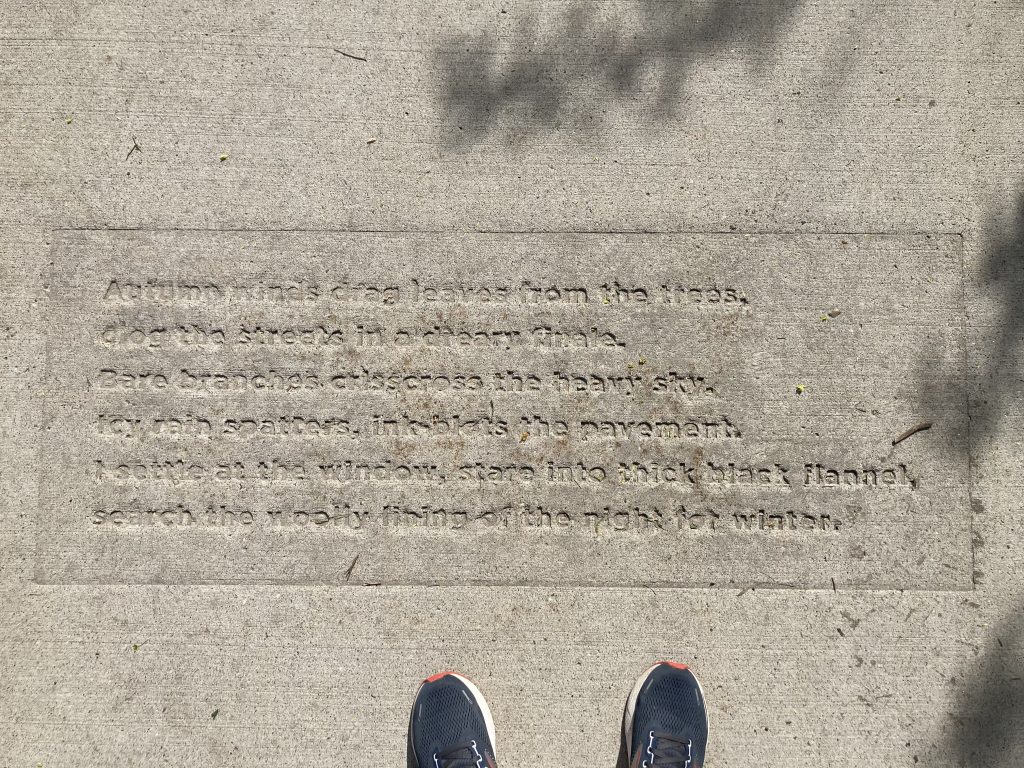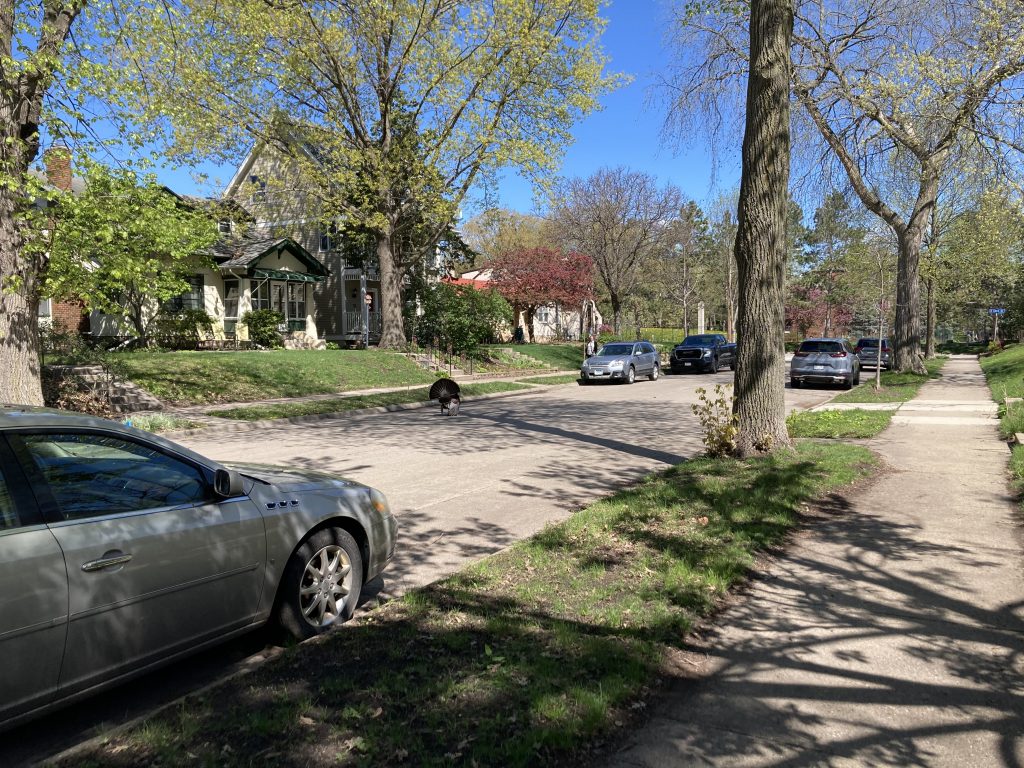4 miles
trestle+ turn around
60 degrees
Okay spring. What a glorious morning! Birds, sun, shadows, green. Ran north, past the trestle. Didn’t see the river (too much green), but said Hi! to Dave and waved to Daddy Long Legs. Encountered, twice, a trio of very fast runners, someone on an eliptigo, and a roller skier.
Thought about shadows as the world of almost — echoes and reflections too. Welcome to the world of almosts not quites nearly theres. Glad you could join me. Some day, I’ll write a poem, or a series of poems, about the almost world I inhabit, where the shadow of a fence feels more real than the fence. As my mind wandered, I also thought about one of my favorite books as a kid: The Shades. I should read it again — just requested it from the library. I would buy it, but it must be out of print: a used copy is $300!
On the way back, I put in my “I’m Shadowing You” and listened to more of my shadow songs:
- I’m Beginning to See the Light
- Twlight
- The Shadow Knows (just the beginning)
- Yesterday
- Moon Shadow
- Golden Years
- Candle Mambo
- If You Go Away
- We Will Become Silhouttes
So many interesting thoughts about shadows, some of them already gone: used to ramble through the park/shadowboxing in the dark — twilight as a time when shades are drawn and silhouettes appear on them — there’s a shadow hanging over me —
And if I ever lose my eyes
If my colors all run dry
Yes, if I ever lose my eyes
Oh if, I won’t have to cry no more
Yes, I am bein’ followed by a moonshadow
Moonshadow, moonshadow
Leapin’ and hoppin’ on a moonshadow
Moonshadow, moonshadow
When this part of “Moonshadow” played I got excited. Yes! Losing my eyes? Color running dry? That’s me. It didn’t make me sad, but almost, strangely (I suppose), joyful in my recognition of my experience. And, yes, I will always have the moonshadow. In fact, as my vision diminishes, shadows are even more meaningful.
Run for the shadows/Run for the shadows
I wondered if the singer in “Candle Mambo” was dancing with his own shadow in the candlelight.
Listening to Neil Diamond’s version of “If You Go Away,” I was struck by the absence of shadows — when the person he loves goes away, all dark; when they’re there, all light. No in-between — either nothing matters, or it matters too much. Neil needs some shadows to temper all his drama.
Just as I reached home, “We Will Become Silhouettes” came on. Very fitting for what I was thinking about before my run:
silhouettes
Thinking about shadows and light, I was reminded of a video I watch 10? years ago on Steven Spielberg and his use of shadow and light. I couldn’t find it, but found something else. Near the end, on a segment featuring shadows, I heard this line:
A rule in comic books is that a character should be recognizable just by looking at their silhouette.
Immediately I thought about forms and my interest in experimenting with how little visual information we need to recognize something — the silhouette as form. I also thought briefly about Platonic Forms. Then I thought about silhouettes, especially the ones I remember making in elementary art class. I looked up “silhouette” and found an article from the Smithsonian: Q and Art: Silhouettes. It mentions the influence of silhouettes on current artists like Kara Walker — Yes! I remember seeing an exhibit of her work at the Walker — in 2007 (I looked it up). Very cool.
I found this video about Walker’s work that I’d like to watch after my run.
The silhouette lends itself to an avoidance of the subject, you know, not being able to look at it directly.
[about Stone Mountain, GA, where Walker grew up, after moving there from Stockton, CA] So that place has a little more resonance. It’s so in-your-face. There’s just no hiding the fact of what black stands for in white america and what white stands for in black america — they’re all loaded with our deepest psychological perversions and fears and longings.
I was tracing outlines of profiles and thinking about physiognomy and racist sciences and minstrelsy and shadow and the dark side of the soul. And I thought, you know, I have black paper here, and I was making silhouette paintings, but they weren’t the same thing. It seemed like the most obvious answer, it took me forever to come to, was just to make a cut in the surface of this black thing. You know I had this black surface and if I just made a cut in it I was creating a hole. It was like the whole world was in there for me.
Discussing her work Insurrection, she describes how overhead projects were used so that the shadows of visitor’s moving through the exhibit would be projected on the work, “so maybe they would feel implicated” in the scene, the history.
I began to love the kind of self promotion surrounding the work of the silhouette artist. They would show up in different towns and advertise their skills, sometimes very overblown language describing their incredible skills: able to cut in less than a minute, 10 seconds, for your likeness, your accurate likenesses. I also began to question this whole idea of accurate likenesses.
vision moment: While watching the video on my iPad, I paused it to transcribe what she was saying. When I put my finer on the iPad to scroll back a little and start again, my finger had disappeared. Georgina Kleege talks about this happening to her in Sight Unseen, but I didn’t remember experiencing it until today. It’s very localized, in one spot, and only if the contrast is bad. Am I mis-seeing this? Is it just the lack of contrast?
a thought about the monthly challenges
I’ve done monthly challenges about individual poets — Mary Oliver, Emily Dickinson, Linda Pastan — or single books — Dart, garbage — or a single poem — Hymn to Life. I’ve studied birds, water, wind, windows, ghosts, shadows. Sometimes, these studies lead to poem, and sometimes they’re the chance to care about something new, something I’ve never noticed or bothered to think about. I love these challenges. Today I loved thinking about silhouettes and remembering art projects I did as a kid and having a chance to think again about art work that I saw years ago but didn’t quite understand.

